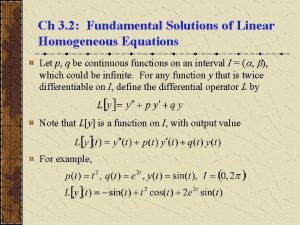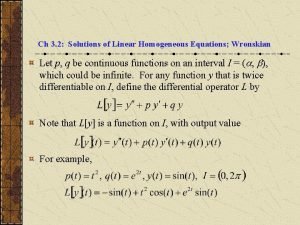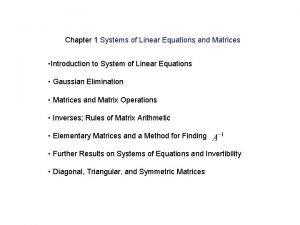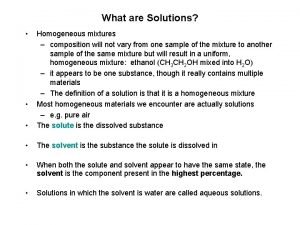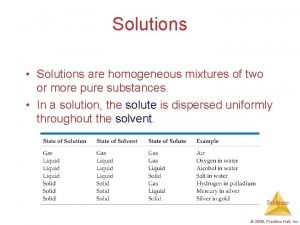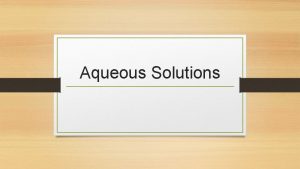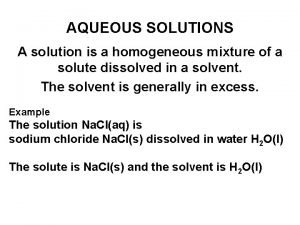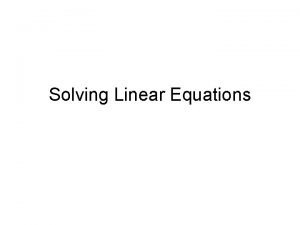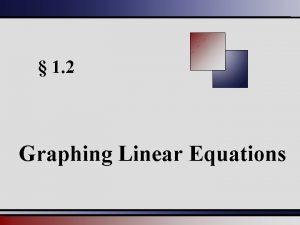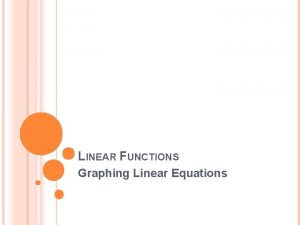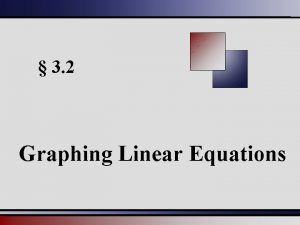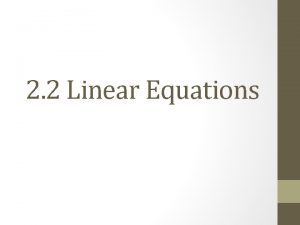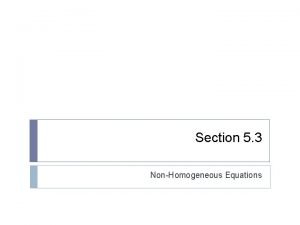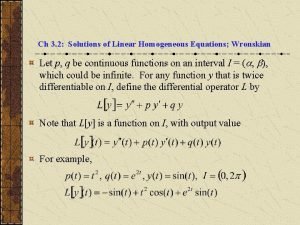Ch 3 2 Solutions of Linear Homogeneous Equations













- Slides: 13

Ch 3. 2: Solutions of Linear Homogeneous Equations; Wronskian Let p, q be continuous functions on an interval I = ( , ), which could be infinite. For any function y that is twice differentiable on I, define the differential operator L by Note that L[y] is a function on I, with output value For example,

Differential Operator Notation In this section we will discuss the second order linear homogeneous equation L[y](t) = 0, along with initial conditions as indicated below: We would like to know if there are solutions to this initial value problem, and if so, are they unique. Also, we would like to know what can be said about the form and structure of solutions that might be helpful in finding solutions to particular problems. These questions are addressed in theorems of this section.

Theorem 3. 2. 1 Consider the initial value problem where p, q, and g are continuous on an open interval I that contains t 0. Then there exists a unique solution y = (t) on I. Note: While this theorem says that a solution to the initial value problem above exists, it is often not possible to write down a useful expression for the solution. This is a major difference between first and second order linear equations.

Theorem 3. 2. 2 (Principle of Superposition) If y 1 and y 2 are solutions to the equation the linear combination c 1 y 1 + y 2 c 2 is also a solution, for all constants c 1 and c 2. To prove this theorem, substitute c 1 y 1 + y 2 c 2 in for y in the equation above, and use the fact that y 1 and y 2 are solutions. Thus for any two solutions y 1 and y 2, we can construct an infinite family of solutions, each of the form y = c 1 y 1 + c 2 y 2. Can all solutions be written this way, or do some solutions have a different form altogether? To answer this question, we use the Wronskian determinant.

The Wronskian Determinant (1 of 3) Suppose y 1 and y 2 are solutions to the equation From Theorem 3. 2. 2, we know that y = c 1 y 1 + c 2 y 2 is a solution to this equation. Next, find coefficients such that y = c 1 y 1 + c 2 y 2 satisfies the initial conditions To do so, we need to solve the following equations:

The Wronskian Determinant Solving the equations, we obtain In terms of determinants: (2 of 3)

The Wronskian Determinant (3 of 3) In order for these formulas to be valid, the determinant W in the denominator cannot be zero: W is called the Wronskian determinant, or more simply, the Wronskian of the solutions y 1 and y 2. We will sometimes use the notation

Theorem 3. 2. 3 Suppose y 1 and y 2 are solutions to the equation and that the Wronskian is not zero at the point t 0 where the initial conditions are assigned. Then there is a choice of constants c 1, c 2 for which y = c 1 y 1 + c 2 y 2 is a solution to the differential equation (1) and initial conditions (2).

Theorem 3. 2. 4 (Fundamental Solutions) Suppose y 1 and y 2 are solutions to the equation If there is a point t 0 such that W(y 1, y 2)(t 0) 0, then the family of solutions y = c 1 y 1 + c 2 y 2 with arbitrary coefficients c 1, c 2 includes every solution to the differential equation. The expression y = c 1 y 1 + c 2 y 2 is called the general solution of the differential equation above, and in this case y 1 and y 2 are said to form a fundamental set of solutions to the differential equation.

Example 6 Consider the general second order linear equation below, with the two solutions indicated: Suppose the functions below are solutions to this equation: The Wronskian of y 1 and y 2 is Thus y 1 and y 2 form a fundamental set of solutions to the equation, and can be used to construct all of its solutions. The general solution is

Example 7: Solutions (1 of 2) Consider the following differential equation: Show that the functions below are fundamental solutions: To show this, first substitute y 1 into the equation: Thus y 1 is a indeed a solution of the differential equation. Similarly, y 2 is also a solution:

Example 7: Fundamental Solutions (2 of 2) Recall that To show that y 1 and y 2 form a fundamental set of solutions, we evaluate the Wronskian of y 1 and y 2: Since W 0 for t > 0, y 1, y 2 form a fundamental set of solutions for the differential equation

Summary To find a general solution of the differential equation we first find two solutions y 1 and y 2. Then make sure there is a point t 0 in the interval such that W(y 1, y 2)(t 0) 0. It follows that y 1 and y 2 form a fundamental set of solutions to the equation, with general solution y = c 1 y 1 + c 2 y 2. If initial conditions are prescribed at a point t 0 in the interval where W 0, then c 1 and c 2 can be chosen to satisfy those conditions.
 Fundamental solutions of linear homogeneous equations
Fundamental solutions of linear homogeneous equations Fundamental solutions of linear homogeneous equations
Fundamental solutions of linear homogeneous equations Homogeneous system of linear equations examples
Homogeneous system of linear equations examples Homogeneous and nonhomogeneous differential equations
Homogeneous and nonhomogeneous differential equations Persamaan simultan
Persamaan simultan Differences between linear and nonlinear equations
Differences between linear and nonlinear equations Metode gauss naif
Metode gauss naif Are solutions homogeneous
Are solutions homogeneous Are all solutions homogeneous mixtures
Are all solutions homogeneous mixtures Gaseous solution
Gaseous solution Are solutions homogeneous
Are solutions homogeneous Solution is
Solution is Are aqueous solutions homogeneous mixtures
Are aqueous solutions homogeneous mixtures Are aqueous solutions homogeneous mixtures
Are aqueous solutions homogeneous mixtures
